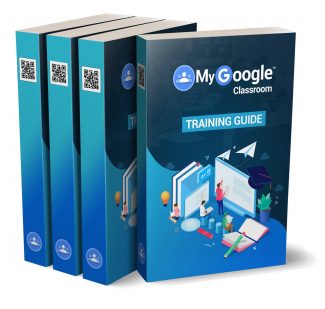 License Type: Personal Use
License Type: Personal Use  File Type: ZIP
File Type: ZIP
 SKU: 63148
SKU: 63148  Shipping: Online Download
Shipping: Online Download
Sample Content Preview
Introduction
Google Classroom program now has 40 million users, 30 million Chromebooks students!
40 million students and educators rely on Google Classroom to stay organized and support creative teaching techniques. 30 million more use Chromebooks to open up a world of possibilities both inside and outside the classroom.
Google Classroom makes organizing and managing all of your Google Apps activities streamlined and easy. Set it up in minutes.
Thousands of teachers are certainly finding their way to Google Classroom. It has been as billed by Google: less focus on tech, more focus on teaching. It has made managing Google Apps files in schools more streamlined and communicating with classes easier. Have you set up Classroom in your classroom? If you’re like many others we know, you might not have for some reason.
Well, now is the time! This guide will show you how to set Classroom up in a matter of minutes and perform the main tasks, easy time saving hacks for teachers, how to analyse usage reports, and so many other handy tips and tricks to make your Google Classroom a success.
Happy Learning!
As the classroom is becoming more and more paperless, teachers have to start finding solutions to hand out assignments, manage their classroom, communicate with students, and so on.
A rapidly growing number of teachers are finding their way to Google Classroom. An ingenious virtual classroom that focusses less on tech and more on teaching. You don’t have to be a tech professional to handle this classroom.
In this post we will explain what Google Classroom is, and what you can or can’t do with it.
What is GC?
Google Classroom helps teachers and students to communicate and can be used to organize and manage assignments, to go paperless, for collaboration between students and between teachers, and so on! You could compare it with iTunes U, Showbie, and other online learning platforms.
It’s built on top of Google Docs and Google Drive, which means it’s very easy to use and intuitive for any teacher. But that doesn’t mean it’s boring. Google Classroom is full of surprises you’ll encounter along the way.
Things you can do with Google Classroom
So this is probably the most important question. Why would you use Google Classroom? What’s in it for you?
First of all, it’s completely free. You won’t have to upgrade to a pro version that will cost you some money. Yes, $0,00. Nothing. At. All.
After you’ve set up your classroom, you can get started. You’ll find out how to set up your Google classroom account in just a few minutes. Here’s a list of the things you can do with it:
- Add announcements and lesson material: Give your students announcements about your lesson. Add lesson materials in the announcements. That way, students
can find everything quickly. You can add materials from a Google drive, connected to that Google Classroom lesson, add files and images from your computer, add a YouTube video or add any other link you want your students to visit. You can add a BookWidgets exercise in just minutes. It’s that easy!
- Add assignments: Just like adding an announcement, you can add an assignment to your course. It works the same way, but here you get the option to add a due date. It will notify your students when they have to make an assignment and it will also appear in their Calendar.
- Grade an assignment: Afterwards, you can check and grade the assignments your students have handed in. There’s room for feedback via a teacher comment. Then, send the assignment back to your students.
- Manage students: Of course, your students have to be able to share comments. Or not? That’s completely up to you! You can manage permissions, giving students the ability to post and comment, only comment, or give only the teacher the ability to post and comment. You can even e-mail your students individually.
Things you can’t do with Google Classroom
There are a few things you should know before you start using Google Classroom with the wrong reasons. It’s an online learning platform, but it isn’t:
- A Chatbox: You can comment on assignments and announcements, but there’s no chat function. If you do want to be in direct contact with your students, you can send them an email, or you can enable other Google apps to take over that function.
- A Test or quiz tool: There are some possibilities when it comes to making quizzes in Google Classroom, but it’s still not meant to be a quiz tool. There are so many other good apps for that.
Option 1: You can add tests and assignments from other educational apps right inside Google Classroom, like for example, an BookWidgets test that gets automatically graded. Option 2: Here’s what you can do inside Google Classroom itself: Add a question. Then choose between an open answer or a multiple choice question. It’s best to choose the first option if you want to make your digital classroom more interactive.
- A discussion forum: You can make announcements, and students can really comment on them, but it’s not a great fit for discussions.
Setting up Google Classroom in 3 simple steps
This means Google Classroom must mean something to you. You’ll find it’s easy to set up and very intuitive to keep on using it. Follow these steps to set up your Google Classroom teacher account:
1. Sign up
When you go to classroom.google.com you can use Classroom by logging in using a G suite e-mail address or you can use it without “claiming” to use it for education. Everything works just fine that way too. It just harder to manage your students if you have hundreds of them. You’ll have to add them one by one.
2. Create your first class
Click on the “+” button in the right upper corner. Choose for “create a class”. Here, you fill in some detail information about your class. Write down a good class name and section. The class name should be the title of your class so you can find it back in a few seconds. Then click on “create”.
3. Invite students to your class
Once you have created your class, you can invite your students. Let them sign using the Google Classroom app by entering the unique code you gave them. You’ll find the code in your created class. Go to the tab “students”. Another option is to invite your students one by one by entering their e-mail address.
Now your online class is ready! At least, it’s there, and everyone can access it. There are a few other things you have to do before you can take off for real.
- Create your first assignment or make an announcement. Click on the “+” button at the bottom in the “updates” tab. Don’t forget to number your assignments. It’s easier for your students to see which one comes first as you are unable to reorder assignments in the stream. Click on the title to see if any students have handed in the assignment and to give grades and feedback. Afterwards, you can return the assignments to your students, so they can start editing again.
- Add some lesson material to your assignment/ class. Add material from Google Drive or add a YouTube video, a file from your computer, a link, etc. You find these options right beneath the due date. If you just want to share a presentation of your class, which is not linked to an assignment, you can go to the tab “about”. Here you can add some lesson material like slides, interesting articles and examples.
- Access the Drive folder. Every time, you create a new class, Google Classroom creates a Drive folder for that class. You can access the folder by going to all your class tiles. On each tile, you’ll find a folder icon. Click on it, and you’re in the folder. Here you can add class materials too. All your students assignments automatically end up in the Google Drive folder, so you’ll find it back whenever you want.
The Best Apps For Your Google Classroom
You can add practically everything to Google Classroom with a link to the website or page. Although, this doesn’t allow students to work interactively with the apps, on the apps. There are a lot of apps that have a built in share button to Google Classroom. This makes it easy for students to open the app via Google Classroom.








